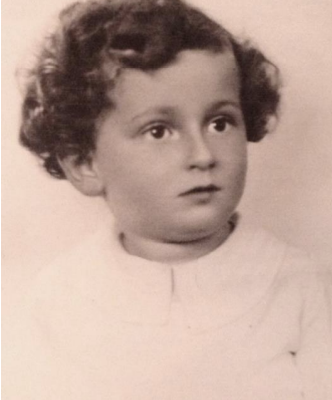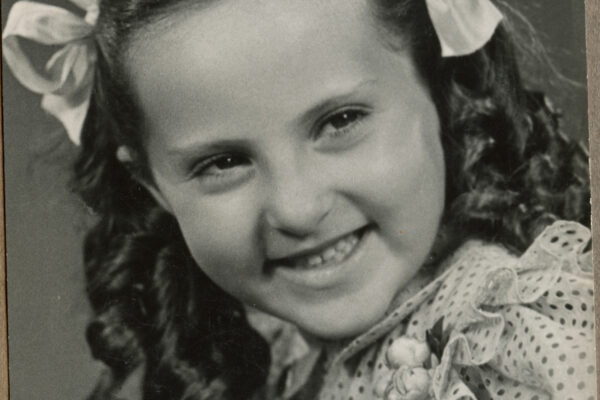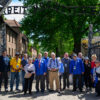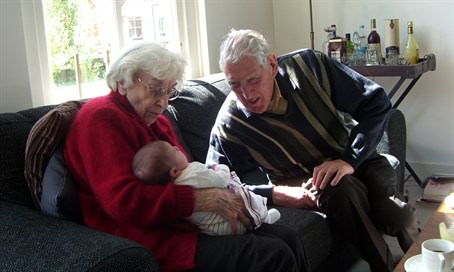
Emanuel and Jetty Jones
As a Dutch Jewish couple hiding separately from the Nazis, Emmanuel Joels and Hetty van Son were literally drawn together by a comic book of Emmanuel’s romantic invention.
After narrowly avoiding deportation to Auschwitz thanks to a policeman’s tip, the young couple spent 2 1/2 years living less than a mile apart, each in the care of rescuers with ties to the resistance in the city of Apeldoorn, 55 miles east of Amsterdam.
It was a fortunate situation in a country where 75 percent of Dutch Jewry were murdered — the highest death rate in Nazi-occupied Western Europe. Their benefactors were so caring that they risked catching Hetty’s tuberculosis, supplying her with the rare luxury of fatty foods to treat her.
Even though they were safe and close, the lovers could not see one another — their hiding places were separated by a major traffic artery for Nazi troops that they could not risk crossing.
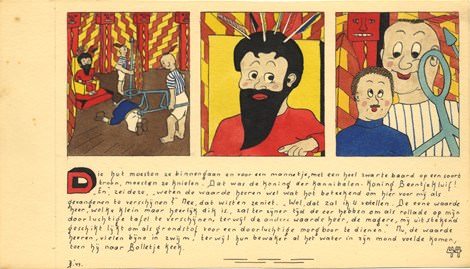
Stopmie Dompie in Rooverije Jet Naftaniel
So Emmanuel – or E., as he calls himself – devised a creative and discreet way for the couple to stay in touch and offer mutual support: He drew his love a colorful comic book, dispatching a new episode each week to her safe house. The courier was Geeske Schurink, the 7-year-old daughter of the family that sheltered E.
Joels’ novel “Stopmie Dompie Meets the Cannibals” Jet Naftaniel
After decades of storage in a cardboard box, E.’s three wartime detective graphic novels about Dompie Stompie, a stick figure detective made out of what appears to be metal wire, finally was published last year. It forms the basis for an exhibition that opened last month at the Jewish Historical Museum here.
The Amsterdam museum, a renowned institution that receives more than 250,000 visits annually, put E.’s “Dompie Stompie Metal Wire Man” series on display as “an illustration of stubborn bravery” during the Holocaust, curator Irene Faber told JTA.
Yet the books – each containing 30-odd pages filled with neatly handwritten text and drawings — do not mention the Holocaust or the war. Rather they are escapist stories about imaginary countries that Dompie Stompie visits in his travels, where he is asked to solve crimes.
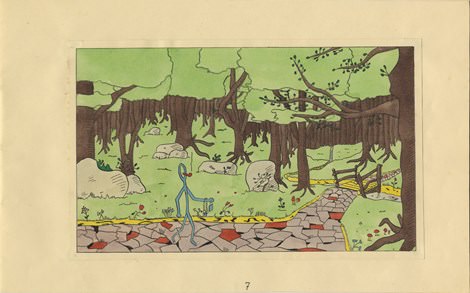
Stopmie Dompie in Rooverije Jet Naftaniel
Joels, a retired finance auditor with a photographic memory who rarely speaks about his emotions, says he took up painting because it was the hobby of choice at the Schurinks, the impoverished family that hid him and several other Jews during the Holocaust.
Bored and cut off from the outside world, Joels brushed up his sketching skills from high school and drew from memory a Monopoly board for the family’s four children. They had never heard of the game.
He says he chose a stick figure for his graphic novels’ protagonist because he was no good at drawing faces. But his oldest daughter, Jet Naftaniel, believes there is more to the choice: She says it “symbolizes simplicity and fortitude” as well as, perhaps, the barbed wire fences that were surrounding ghettos and concentration camps.
Joels says he found his own drawings “silly.” But after the war, he adopted the stick figure as his John Hancock and would often make humorous references to Dompie Stompie’s adventures around the dinner table, Jet says.
In the third and final “Dompie Stompie” volume, the detective is set upon by a bird of prey that resembles the Imperial Eagle that featured heavily in Nazi imagery. The bird drops Dompie in front of a camouflaged bunker that evokes the author’s own life in hiding.
Joels, now 97 and living in an assisted-living facility, says he never intended such allusions, attempting merely to entertain his fiancee with drawings that would betray neither their author nor intended reader in case they were ever intercepted. They were married shortly after the war ended.
For him, the “Dompie” series was primarily a way of keeping his promise to Hetty, who passed away last year, that they would always offer each other positive “light points” no matter what hardships life threw at them.
By the time they were 25, life had thrown quite a few hardships their way. Before going into hiding, Hetty was forced out of her training position as a buyer for a department store in Amsterdam. She became a nurse at a Jewish psychiatric hospital in her hometown of Apeldoorn – one of the few places where Jews could still work under Nazi occupation, and the place where she contracted her lung disease.
Joels followed her there, escaping with her just hours before the Nazis raided the institution and sent all the patients and staff in cattle cars for immediate execution at Auschwitz. They both lost family members in Nazi death camps.
After the war, the couple seldom spoke about their traumas. Joels would read from the “Dompie Stompie” books to Jet and her younger sister, Marian, but it gave them nightmares, Jet recalls.
“Our parents would only tell us about the positive things from the Holocaust, but even as a child that didn’t add up,” she said. “We knew relatives died there and we sensed the tension in their voices. They gave us their anxieties without ever speaking about them.”
Jet and Marian found the drawings in a box buried deep in a closet a few years ago while moving their parents to an assisted living facility, Jet recalls.
“It’s a nice family story, but it’s also a story of the incredible willpower of my parents and their whole generation not to succumb to darkness even when resisting it seemed pointless,” she said.
Joels and his family gave the first copy of the “Dompie Stompie” series to Geeske Schurink, the little girl who delivered his episodes across the street to Hetty. Geeske never said a word about the guests, who would huddle together in the attic whenever the Schurinks received visits – including by some Nazi relatives.
“It was one of the many unbelievable things that happened then, that none of the children, no matter how young, ever told anyone about the people in hiding in their home,” Joels said.
Originally published HERE
